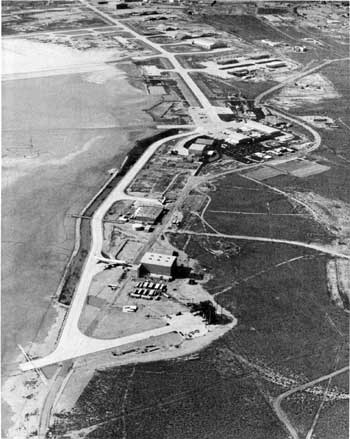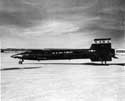.gif)
|
Man in Space
A National Historic Landmark Theme Study |

|
|
Other Support Facilities |

Dryden Flight Research Center and Edwards Air Force Base
next to the Rogers Dry Lake, 1983.
(Courtesy of NASA, NASA/Dryden Flight Research Center)
Rogers Dry Lake
| Name: | Rogers Dry Lake (Muroc Dry Lake) |
| Location: | Edwards Air Force Base, California |
| Owner: | U.S. Air Force/LEEV |
| Condition: | Excellent, unaltered, original site |
| Builder/Architect: | N/A |
| Dates: | 1933-Present |
DESCRIPTION
Rogers Dry Lake is within the boundaries of Edwards Air Force Base in California, approximately 100 miles northeast of Los Angeles. Rogers Dry Lake is part of the Antelope Valley region of the Mojave Desert and is bounded by the Soledad Mountains, the Sierra Pelona ranges of the San Gabriel Mountains, the Long Buttes, and the Tehachapi Mountains. The lake forms the lowpoint of the Antelope Valley which ranges in altitude from 2,300 to 3,000 feet above sea level.
Rogers Dry Lake is sixty-five miles square and shaped roughly like a lopsided figure-8, 12 1/2 miles long and 5 miles wide. It is a pluvial lake that was formed during the late Pleistocene Era about 2.5-million years ago. The lake is naturally flat and its surface is unusually hard and can support up to 250 pounds per square inch of pressure enabling even the heaviest aircraft to land and take off from the lake bed. The lake is dry for most of the year except for brief occasions when rainfall fills the lake bottom to a depth of a few inches.
Rogers Dry Lake has 60 miles of marked and maintained runways which are 300 feet wide. Its broad expanse of hardened clay surface forms the largest natural landing field in the world.
STATEMENT OF SIGNIFICANCE
Rogers Dry Lake is the primary resource associated with and responsible for the establishment of Edwards Air Force Base and the Dryden Flight Research Facility. Edwards AFB is the world's premier flight testing and flight research center. Both Edwards and Dryden have had a profound impact on the development of aerospace technology and military security. It is precisely the presence of the natural attributes of clean air, isolated location, ideal weather, variable terrain, and the large expanse of dry lakebeds that first attracted the Army to the Rogers Dry Lake in 1933. These natural assets enabled the military and later the National Advisory Committee for Aeronautics (NACA) and the National Aeronautics and Space Administration (NASA) to flight test aircraft that were on the cutting edge in aviation and aerospace technology. Starting in 1947 with the flight of the Bell X-l, the first plane to break the sound barrier, to the landing of the Space Shuttle Columbia in 1981, Rogers Dry Lake has been the scene of the most important developments in the history of aviation.
GENERAL HISTORY
Rogers Dry Lake area was little more that a watering stop for the Atchison, Topeka & Santa Fe Railroad until 1910 when the Corum family settled near the lake. [1]
Clifford Corum, his wife Effie, and his brother Ralph were homesteaders and were the earliest known settlers of this region. Seeking to attract others to the area they built a combination store and post office. Effie drove the family buggy across the scorching desert seeking the necessary signatures for a petition that would officially give the Corum name to their post office. When the Postal Department rejected the name because of its similarity to another California town, the Corums persisted in immortalizing their name. They decided to reverse the letters in Corum and the name Muroc was born.
Muroc was first used by the military in 1933 when a small advance party from March Field in Riverside came to design and maintain a bombing range for the Army Air Corps. Four years later, the entire Air Corps was performing bombing and gunnery maneuvers here.
At the outbreak of World War II, the south end of the lake was used for training P-38 Lightning fighter pilots, and B-24 Liberator and B-25 Mitchell bomber crews.
Bombing practice targets included a realistic 650-foot model of a Japanese Navy heavy cruiser, dubbed the "Muroc-Maru." Pilots and bombardiers used the "ship" for strafing, identification, and skip bombing practice. The Muroc-Maru passed from landmark to legend in 1950 when it was "sunk" as a flight hazard by Army engineers, who first had to rid the hull of unexploded bombs.
In February 1942, Col. Benjamin W. Chidlaw and Lt. Col. Ralph P. Swofford of the Materiel Center at Wright Field, Ohio, on an extended tour of the western United States, chose Muroc Dry Lake as the ideal location to test the new "super secret" Bell-built XP-59 jet airplane.
Later, negotiations with the Muroc Bombing and Gunnery Range commanding officer, Maj. Glen L. Arbogast, resulted in assignment of a portion of Muroc Dry Lake north of the Santa Fe Railroad for exclusive use of the Materiel Center personnel who had been directed to proceed to Muroc, California, to take charge of the "Materiel Center Flight Test Site." In September 1942, America's first jet arrived at Muroc by rail. While it was being readied for its first flight, a wooden propeller was attached to the nose of the aircraft to disguise its jet propulsion. The XP-59A made its first flight October 1, 1942.
As tests of the XP-59A progressed, it became apparent that the location was ideal for testing aircraft. In addition to a climate assuring 350 days a year flying weather, the dry lake was a ready-made emergency landing field for experimental aircraft.
From December 1942 the base was called the Materiel Command Flight Test Base. In 1944 it was redesignated the Muroc Flight Test Base. In October 1946 the Muroc Flight Test Base on the north end of Muroc Dry Lake and the Bombing and Gunnery Crew Training Base on the south end of the dry lake merged into a single flight test facility at Muroc Army Air Field under the jurisdiction of the Air Materiel Command.
Muroc Army Air Field was redesignated Muroc Air Force Base in February 1948 and became Edwards Air Force Base in February 1949 in honor Capt. Glen W. Edwards. A native of Lincoln, California, Captain Edwards had been killed June 5, 1948, during a performance test of a YB-49 "flying wing" experimental jet bomber. Official dedication of the newly named Edwards AFB took place January 27, 1950.
Through the years, Edwards has been the focal point for testing and evaluating aircraft concepts and designs and has contributed directly to the improved combat capability of the Air Force. Many aerospace "firsts" have occurred in the skies above Edwards. Capt. Charles E. Yeager became the first man to break the once-feared sound barrier. He accomplished this feat October 14, 1947, in the Bell X-1 experimental rocket plane. This led directly to the development of the supersonic Century Series of fighter aircraft beginning with the F100 Super Sabre.
The three X-15s, the world's fastest and highest flying winged aircraft, were tested from 1959 until 1968. Knowledge gained from their 199 flights in the research program hastened the day of the United States manned space and moon flights.
The second X-15, now on display at the Air Force Museum, Wright-Patterson AFB, Dayton, Ohio, set an unofficial world speed record of 4,520 mph October 3, 1967. The X-15s reached altitudes of more than 67 miles. Other test projects have included the XB-70A triple-sonic Air Force research aircraft, the F-111A supersonic variable sweep-wing jet fighter, the X-13 vertical take-off and landing airplane, and the C-5A Galaxy cargo aircraft.
After the X-15, the Air Force-National Aeronautic and Space Administration (NASA) research partnership turned to a different kind of experimental rocket craft--a specially contoured, wingless vehicle called the lifting body.
Not designed for speed like the X15s, the lifting bodies were shaped to fly both as a spacecraft and a wingless airplane. They were tested to determine their qualities for an extended near-earth flight and for conventional runway approach and landing. The knowledge gained from the lifting body research has aided in the development of the space shuttle.
The shuttle eliminates costly "throw-away" boosters and ocean splashdowns. Edwards AFB was the prime landing site for all space shuttle tests and development flights. During the entire life of the space shuttle program the desert base, with its uniquely qualified large drylake bed, will continue to be a contingency landing site on any orbital mission.
The natural resource of Rogers Dry Lake has made possible the successful development and testing of generations of American aircraft leading to the Space Shuttle today. Because of this association with the History of American Aviation the Rogers Dry Lake is uniquely qualified for designation as a National Historic Landmark.
FOOTNOTES
1. The descriptive material for the general history of this section has been taken from Antelope Valley Salutes Edwards AFB (Riverside, Ca.: Armed Services Press, 1982), pp. 37-9.
BIBLIOGRAPHY
Antelope Valley Salutes Edwards AFB. Riverside, Ca.: Armed Services Press, 1982.
National Aeronautics and Space Administration. Flight Research Center. No place of publication, No publisher listed, no date given.
National Aeronautics and Space Administration. Hugh L. Dryden Flight Research Center Environmental Resources Document, Edwards, Ca.: Hugh L. Dryden Flight Research Center, 1980
National Aeronautics and Space Administration. NASA Dryden. Edwards, Ca.: Hugh L. Dryden Flight Research Center, no date.
National Aeronautics and Space Administration. NASA FACTS: Ames Research Center Hugh L. Dryden Flight Research Facility. Edwards, Ca.: Hugh L. Dryden Flight Research Facility, 1982.
APPENDIX A
Rogers Dry Lake UTM References
Rogers Dry Lake North
A. 11/428690/3868300
B. 11/428958/3864000
C. 11/426060/3859300
Rogers Dry Lake South
D. 11/425600/3854900
E. 11/422870/3850280
F. 11/420000/3853950
Redman
G. 11/416960/3856160
H. 11/417500/3857800
I. 11/420030/3859000
Rogers Dry Lake North
J. 11/421040/3860710
K. 11/420040/3865460
Edwards
L. 11/418850/3864560
M. 11/420150/3870860
Rogers Dry Lake North
N. 11/422950/3872940
O. 11/425860/3871360
PHOTOGRAPHS
(click on the above photographs for a more detailed view)
Last Modified: Mon, Jan 8 2001 10:00:00 am PDT
man-in-space/space24.htm





 Top
Top